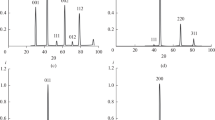Abstract
The changes in electrical resistivity of palladium solid solution alloys (alloying element = silver, gold, copper, yttrium, cerium, titanium, zirconium, vanadium, niobium and tantalum) with hydrogen concentration were measured at 301 K up to aboutr(H/M) = 1.5×10−2; the hydrogen was introduced by electrolysis and measurements of electrode potential were also made. The specific electrical resistivity increment per unit change of hydrogen concentration, ∂Δϱ1∂r, generally increases with increase of the solute contents, although for silver, gold and copper there are no notable changes in the slopes with their concentrations. The increase in ∂Δ/g9/∂r with the alloying contents cannot be related to the lattice “dilatation” effect due to the solute, but it is associated approximately with a decrease in the density-of-states at the Fermi level caused by pre-filling of the 4 d band of palladium by the solute atoms.
Similar content being viewed by others
References
F. A. Lewis, “The Palladium-Hydrogen Systems” (Academic Press, New York, 1967).
T. B. Flanagan andF. A. Lewis,Trans. Faraday Soc. 55 (1959) 1400.
J. C. Barton, F. A. Lewis andI. Woodward,ibid. 59 (1963) 1201.
A. W. Carson, T. B. Flanagan andF. A. Lewis,ibid. 56 (1960) 363.
B. Baranowski, F. A. Lewis, W. D. McFall, S. Filipek andT. C. Witherspoon,Proc. Roy. Soc. London A386 (1983) 309.
J. C. Barton, J. A. S. Green andF. A. Lewis,Trans. Faraday Soc. 62 (1966) 960.
M. Laprade, K. D. Allard, J. F. Lynch andT. B. Flanagan,J. Chem. Soc. Faraday Trans. I 70 (1974) 1615.
D. Artman, J. F. Lynch andT. B. Flanagan,J. Less-Common Metals 45 (1976) 215.
K. Kandasamy, F. A. Lewis, W. D. Mcfall andR. A. Mcnicholl,Z. Phys. Chem. N.F.,163 (1989) 41.
D. A. Smith andI. R. Harris,Ibid. 147 (1986) 1.
A. W. Carson, F. A. Lewis andW. H. Schurter,Trans. Faraday Soc. 63 (1967) 1447.
A. Maeland, PhD thesis, University of Vermont (1964).
K. D. Allard, J. F. Lynch andT. B. Flanagan,Z. Phys. Chem. N.F. 93 (1974) 15.
D. Fisher, D. M. Chisdes andT. B. Flanagan,J. Solid Stale Chem. 20 (1977) 149.
R. Burch andR. G. Buss,J. Chem. Soc. Faraday Trans. I 71 (1975) 913.
H. Brodowsky andE. Poeschel,Z. Phys. Chem. N.F. 44 (1965) 143.
R. Burch andR. G. Buss,J. Chem. Soc. Faraday Trans. I 71 (1975) 922.
R. Burch AndN. B. Mason,ibid. 76 (1980) 2285.
J. D. Clewley, J. F. Lynch andT. B. Flanagan,ibid. 73 (1977) 494.
Y. Sakamoto, K. Kajihara, Y. Fukusaki andT. B. Flanagan,Z. Phys. Chem. N.F. 159 (1988) 61.
Y. Sakamoto, T. Matsuo, H. Sakai andT. B. Flanagan,ibid. 162 (1989) 83.
N. F. Mott andH. Jones,“The Theory of Metals and Alloys” (Oxford University Press, 1935).
N. Kuwano, T. Shiwaku, Y. Tomokiyo andT. Eguchi,Jpn. J. Appl. Phys. 20 (1981) 1603.
D. A. Smith, I. P. Jones andI. R. Harris,J. Mater. Sci. Lett. 1 (1982) 463.
Y. Sakamoto, T. B. Flanagan andT. Kuji,Z. Phys. Chem. N.F. 143 (1985) 61.
Y. Sakamoto, M. Yoshida AndT. B. Flanagan,J. Mater. Res. 1 (1986) 781.
K. Baba, Y. Sakamoto AndT. B. Flanagan,J. Chem. Soc. Faraday Trans. I 84 (1988) 459.
Y. Sakamoto, K. Kajihara, T. Kikumura andT. B. Flanagan,J. Chem. Soc. Faraday Trans. 86 (1990) 377.
B. Svensson,Ann. Phys. 14 (1932) 699.
E. Kudielka-Artner andB. B. Argent,Proc. Phys. Soc. 80 (1962) 1143.
Japan Institute of Metals (eds), “Metals Data Hand Book”, (Maruzen, Tokyo, 1974).
Y. Sakamoto, K. Yuwasa andK. Hirayama,J. Less-Common Metals 88 (1982) 115.
Y. Sakamoto, H. Kaneko, T. Tsukahara andS. Hirata,Scripta Metall. 21 (1987) 415.
Y. Sakamoto, K. Baba andT. B. Flanagan,Z. Phys. Chem. N.F. 158 (1988) 223.
Author information
Authors and Affiliations
Rights and permissions
About this article
Cite this article
Baba, K., Miyagawa, U., Watanabe, K. et al. Electrical resistivity changes due to interstitial hydrogen in palladium-rich substitutional alloys. J Mater Sci 25, 3910–3916 (1990). https://doi.org/10.1007/BF00582459
Received:
Accepted:
Issue Date:
DOI: https://doi.org/10.1007/BF00582459




